Mites
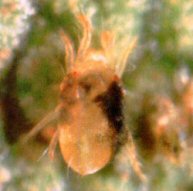
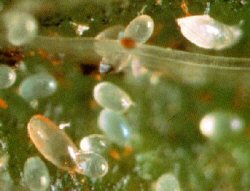
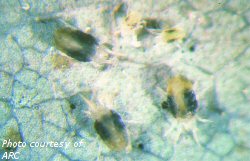
Two-spotted spider mite adults
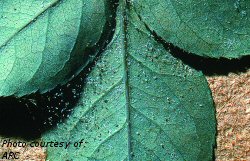
Two-spotted spider mites on underside of rose
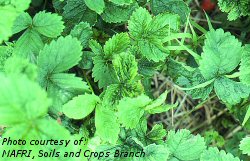
Cyclamen mite damage on strawberry
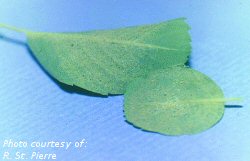
McDaniel's spider mite on saskatoon leaf
Biology
The two-spotted spider mite is the most prevalent and most damaging mite affecting strawberries on the prairies. It is a small (about 0.5 mm), oval, usually greenish-yellow mite. It has 2 irregular dark spots on its back. The cyclamen mite is oval, light-green, shiny amber or light-tan coloured, and semi-transparent. When mature, cyclamen mites are about 0.25 mm long. The young nymphs are milky-white. The adult female mite is pale-brown.
Mites are not insects but are close relatives of spiders. Nymphs (immatures) have 3 pairs of legs and adults have 4 pair. These mites overwinter as adults in debris or on old host plants. There can be several generations per year. The TSSM is generally found on the underside of leaves in the webbing they have spun. McDaniel’s spider mite also feeds on the underside of the leaves and produces webbing. Cyclamen mites are found in the folds of unopened leaves and usually try to avoid light. All three mites are very small (0.5 mm) and require the use of a hand lens to be able to see individual mites.
Symptoms Of Damage
The two-spotted spider mite feeds on the undersurface of strawberry foliage, especially young leaves in the crown. Feeding causes discolouration, leaf crinklage, and (sometimes) browning and curling of the leaves. When populations of two-spotted spider mites are very high, there is a general loss in plant vigour and, in the worst cases, no fruit forms.
Because the small cyclamen mite is impossible to see with the unaided eye, growers may mis-diagnose the cause of damage as mistakes in cultural management, spray injury, winter injury, or viral disease. All aerial parts can be injured by this mite. Young, new growth is very susceptible and will develop abnormally. Flower buds may not open or blossoms may be destroyed and drop early. Leaves often appear crinkled, twisted, and stunted. Leaf yellowing and dieback can also occur. Severe symptoms can be apparent even when mite populations are low.
Both the TSSM and McDaniel’s mites produce webbing on the underside of the leaves, which is readily visible even though the mites are microscopic. TSSM feeding causes plants to have small red or bronzed leaves that may dry and fall off due to heavy infestations. McDaniel’s mite feeds on leaf and flower buds in the spring and moves to leaves later on. Feeding by this mite causes leaves to have a stippled appearance, leading to yellowing, and eventually may cause leaves to drop off the plant. Cyclamen mite feeding causes leaves to appear crinkled, twisted and stunted. Leaf yellowing is an occasional symptom. All above-ground plant parts are susceptible to damage caused by feeding by this mite. In general, feeding by mites may result in plants that may be stunted. Heavy infestations reduce plant vigour, resulting in decreased fruit size and yield.
Monitoring
The undersides of mite-infested leaves may be covered with fine webbing. In severe infestations, the foliage becomes yellow, then grey, then dry, and finally dies. The overall appearance may be of "bronze" foliage. To avoid a build-up of mite populations, the under surfaces of leaves should be closely inspected for mites every 10 days throughout the growing season. Use a hand lens to see the individual mites (they are smaller than the period at the end of this sentence). Check individual leaves that appear stippled, mottled, yellowish, or bronzed.
With the two-spotted spider mite, closely examine any webbing found between or beneath leaflets for the tiny orange-red mites and their white cast skins. A simple but effective diagnostic tool is to breathe on the back of the leaf. Warm, moist air will cause mites to move, making them more visible. Tapping a leaf over a white sheet of paper is also effective in making these tiny pests more visible. With the cyclamen mite, check for these mites along the midrib of leaflets, where they join the petiole.
Economic Thresholds
A variety of thresholds have been established in different areas of North America. In general, if 20% of the leaves are infested, control measures should be undertaken. Excessive use of insecticides may result in increased mite populations due to killing off of natural enemies. Use of predatory mites can effectively keep populations below damaging levels. Remember that insecticides can kill off predatory mite populations and other beneficial mite predators.
Two-Spotted Spider Mites
If the mite population reaches 20-25 mites per leaflet by late April or early May, the use of a recommended miticide is advised. If populations do not reach these levels until a week or two before harvest, treatment is probably not necessary.
Cyclamen Mites
Monitoring and control should begin early in the growing season. Treatment may be necessary if there are 1 to 15 mites per leaf. Densities of 45-65 mites per leaf can cause a 33 per cent yield reduction.
Host Plants And Distribution
The two-spotted spider mite (TSSM) is found on a variety of plants, but strawberry and raspberry are of concern to fruit growers. TSSM is widespread throughout North America. The cyclamen mite is primarily a greenhouse pest but can be a serious pest in strawberries. It is found throughout North America also. McDaniel’s spider mite is a pest of saskatoon and it is known to occur across the Canadian Prairies.
Scouting Techniques
Plants should be inspected every 10-14 days for presence of mites. Check leaves that appear stippled, mottled, yellowed or bronzed. TSSM and McDaniel’s mites may be monitored by inspecting underside of leaves for presence of webbing. Cyclamen mite may be scouted by examining folded leaves in crown of plant. Mite feeding may be confused with nutrient deficiency. Inspect plants before applying control measures, and use products registered for control of mites, as not all insecticides will kill mites.
Comments
To reduce mite problems on strawberries, irrigate regularly to avoid water stress, purchase only "mite-free" plants, eliminate weeds that can act as alternate hosts in and near strawberry plantings, and cultivate in the fall to disturb the over-wintering sites in soil little used by the mites.
